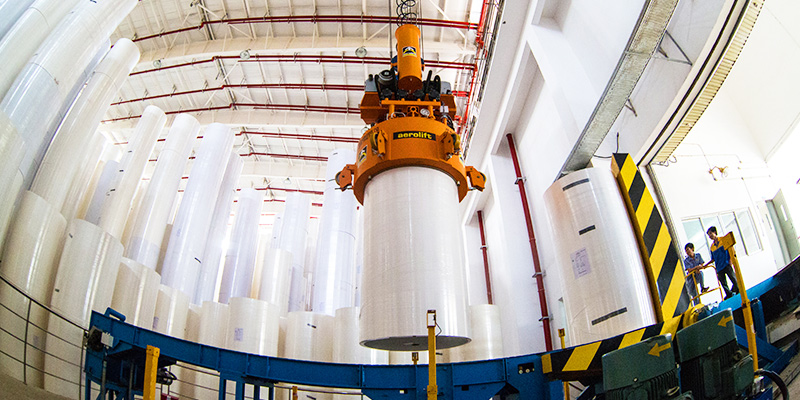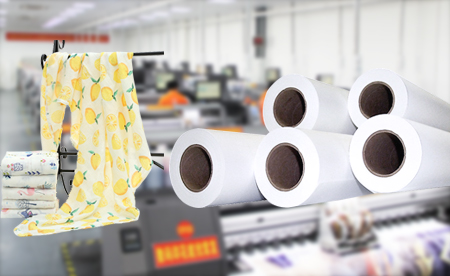HOT SALE
APPLICATION
Phone:+86-15215969856 E-Mail: 396838165@qq.com
In the realm of textile printing, polyester fabrics are widely used across various fields, from activewear to household items, due to their strength and adaptability. However, getting bright and lasting designs on polyester isn’t straightforward. It calls for unique methods and supplies. Two common choices often debated are sublimation paper and tissue paper. This piece dives into which option works better for printing on polyester by looking at how they perform, their costs, and their real-world uses.
Overview of Polyester Fabric Printing Techniques
Printing on polyester needs careful attention because of its man-made makeup. Unlike cotton or other natural materials, polyester doesn’t soak up water-based inks well. That’s why heat transfer methods are a must.
Key Characteristics of Polyester Fabrics in Printing
Polyester has a non-absorbent, sleek surface. This makes it perfect for sublimation printing. In this process, dye turns into a gas when heated and merges with the fabric on a deep level. The result? Bright designs that are woven right into the material itself.
The Role of Heat Transfer in Polyester Printing
Heat transfer is vital for sublimation printing. It lets dyes change into gas and stick to polyester without needing extra glues or layers. This approach gives clear, tough images that resist fading or breaking over time.
What is Sublimation Paper and How It Works
Sublimation Paper is a key player in moving ink onto polyester fabrics using heat and pressure.
Composition and Coating of Sublimation Paper
Changfa Digital has been a trusted name in making sublimation paper and offering digital printing services for over 15 years. They handle everything from raw paper to coating, cutting, and shipping worldwide. Sublimation Paper comes with a unique layer that holds dye inks on its surface until heat triggers their shift to the fabric.
Benefits of Using Sublimation Paper for Polyester
Choosing Sublimation Paper brings several perks compared to other options like tissue paper.
High Color Transfer Efficiency
The special layer on Sublimation Paper keeps most of the ink in place until it’s transferred. This leads to bold, rich colors on polyester materials.
Sharp Image Reproduction
Since Sublimation Paper keeps ink steady on its surface, it creates clean edges and detailed pictures during the heat transfer.
Reduced Ink Bleeding
Its custom coating cuts down on ink spreading. This helps keep designs intact, which is super important for complex patterns or small text.
Exploring the Use of Tissue Paper in Sublimation
Though not a full replacement for Sublimation Paper, Tissue Paper has its own uses during heat transfer tasks.
Functions of Tissue Paper During Heat Transfer
Tissue Paper works as a shield between the heat press parts and the printed items. It often stops extra ink from staining the machine or other layers during big printing jobs.
Advantages and Limitations of Tissue Paper
Tissue Paper offers some pluses but also comes with clear downsides when compared to coated Sublimation Paper.
Protection Against Ink Blow-Through
Weight: 30 g/m² (white paper), Width: 160 cm, 162 cm, 180 cm, or 182 cm, Length: 1000 m/roll. Purpose: This tissue paper is primarily used as a protective layer during large-scale transfer processes to prevent unwanted ink spread to other surfaces.
Cost Considerations Compared to Sublimation Paper
Tissue Paper usually costs less than coated Sublimation Paper. This makes it a tempting pick for those watching their budget. However, it often sacrifices print sharpness when used as the main transfer tool.
Comparing Sublimation Paper and Tissue Paper for Polyester Fabric Printing
To figure out which material suits your needs best, it’s helpful to stack them up on a few important points.
Print Quality and Color Fidelity Comparison
Sublimation Paper stands out with better image clearness and lively colors thanks to its special layers. On the other hand, Tissue Paper doesn’t have this. If used directly for transfers, it often results in less vibrant prints.
Durability and Consistency in Large-Scale Production
Changfa Digital runs 4 coating lines, 4 cutting areas, and 10 machines for 2 and 3 core packing rolls. Such strong setups ensure steady quality for huge orders. This is tough to match with plain Tissue Paper because it absorbs ink unevenly.
Environmental Impact and Waste Management
Sublimation Paper is made for one-time use, but often has recyclable parts like cores and wrappers. Tissue Paper might create less waste per piece. Yet, it’s less efficient due to possible errors or the need to redo prints because of poor image quality.
Cost-Efficiency Over Time
At first glance, Tissue Paper seems cheaper. But its drawbacks can add up costs with reprints or extra machine care. Sublimation Paper, though, gives better worth in the long run by cutting down mistakes and boosting results.
When to Choose Sublimation Paper Over Tissue Paper
There are certain cases where Sublimation Paper is the obvious pick, even if it costs more upfront.
Scenarios Requiring High-Resolution Output
For things like photo prints or detailed logos on sportswear or promo goods, Sublimation Paper captures every tiny detail perfectly during the transfer.
Use Cases in Professional Textile Production
Changfa Digital brought in a top-notch coating line from Germany for daily Sublimation Paper production. This move shows how crucial high-quality transfer materials are in serious textile work where steady results are everything.
When Tissue Paper Can Be a Viable Option
Even with its limits, Tissue Paper still has a place in some printing situations.
Applications in Budget-Conscious or Disposable Prints
For short-term signs or trial prints where perfect visuals aren’t a big deal, Tissue Paper can save money without hurting the outcome too much.
Supporting Role as Backing or Protection Layer
Tissue Paper shines as a backup layer during multi-layer pressing. It stops mess between layers or machine parts. This makes it handy even when used with top materials like Sublimation Paper.
Common Misconceptions About Sublimating on Tissue Paper
Wrong ideas about Tissue Paper’s abilities often lead people to waste time trying direct transfers on polyester with just this material.
Can You Sublimate Directly on Tissue? Clarifying the Process
While it’s doable in rare cases, sublimating straight on Tissue Paper hardly ever gives pro-level results. It lacks the ink-holding layers of real Sublimation Paper. So, it’s better seen as a helper material, not a stand-in.
Why Results May Vary with Non-Coated Papers
Plain Tissue Paper soaks up ink in uneven ways. This causes washed-out colors or blurry effects after transfer. Only coated materials ensure even color release during heat processes used on polyester.
Introducing Changfa Digital as a Trusted Supplier in the Industry
For companies looking for dependability in product standards and delivery, Changfa Digital is a top name worldwide among makers of digital textile tools.
Comprehensive Product Line: Sublimation Papers, Inks, Printers, Machines, and Tissues
Changfa Digital provides all sorts of Sublimation Paper and digital printing help. Their key items include weights like 29gsm, 35gsm, 40gsm, 50gsm, 60gsm, and widths from 61cm to 190cm. Their wide range covers high-density inks for Epson I3200 nozzles to PET films for DTF printers. Everything is available in one place for convenient use in your projects.
Commitment to Quality Control and Innovation in Heat Transfer Solutions
Changfa Digital produces 3000 tons monthly and ships 120 containers worldwide each month. This huge scale shows not just their output but also tight quality checks. Every roll meets high global rules before it reaches buyers around the world.
Conclusion: Making the Right Choice for Your Polyester Printing Needs
Deciding between Sublimation Paper and trying to sublimate on Tissue Paper hinges on what you aim to achieve. Are you focused on top-notch images or keeping costs low?
Think about your exact needs, like how clear the prints must be or how much you’re producing. This will help you pick materials that match both your technical goals and budget limits. For most serious projects with polyester, especially where toughness counts, Sublimation Paper is the best bet for great results.
FAQs:
Q1: Can I use regular tissue instead of Sublimation Paper?
A: No, you shouldn’t. Regular Tissue Paper doesn’t have the needed layer to hold dye properly during heat transfer. It might work as a shield against ink leaks, but it can’t take the place of real Sublimation Paper if you want clear images on polyester.
Q2: Why do my prints look faded when using Tissue Paper instead of coated stuff?
A: Fading happens because plain Tissue Paper takes in ink unevenly. It doesn’t keep ink on the surface like coated Sublimation Paper does. So, less dye gets to the fabric during heat pressing, and the result looks dull.
Q3: What makes Changfa Digital’s products good for big operations?
A: Changfa Digital is a skilled maker of Sublimation Paper, handling everything from raw paper to coating and cutting. Their all-in-one process guarantees steady quality across large amounts, perfect for businesses needing a solid supply with little delay.










